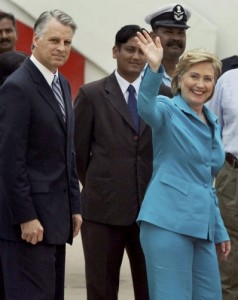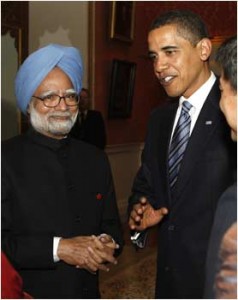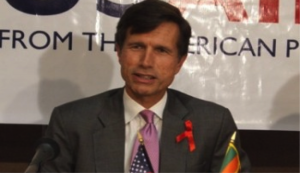Looking Ahead: U.S.-India Strategic Relations and the Transpacific Century
Thank you so much for inviting me to speak at the National Bureau of Asian Research’s launch of their heralded Strategic Asia volume. I am
particularly pleased to have this opportunity given that this year’s title is Strategic Asia 2011-12: Asia Responds to Its Rising Powers – China and India.
I want to salute the National Bureau of Asian Research for their pertinent and professional analysis on Asia, and the importance of their work to policy makers around the world.
While my colleague and friend Kurt Campbell – who spoke to this audience just one year ago – is better primed to speak to the China piece of the puzzle, I’m pleased to be with you today to discuss how our strategic relations with India will shape the world we live in, as the world settles into the still young – and at times turbulent – 21st century.
U.S.-India Strategic Dialogue Overview
I’d first like to focus my remarks today on the Secretary of State’s recent travels to India, and – given the premise of today’s event – discuss our support for India’s broadened engagement in Asia, which was the crux of the Secretary’s major policy speech in Chennai.
Secretary Clinton’s monumental trip to six countries in July was jokingly dubbed “the odyssey.” A key stop on the itinerary was India, where the Secretary co-chaired with External Affairs Minister Krishna the second U.S.-India Strategic Dialogue, almost two years to the day after her inaugural visit to New Delhi as Secretary of State.
The relationship has come a long way in the last two years – from cooperation in defense and clean energy to education and space, the relationship’s unprecedented breadth has become one of its distinguishing features. What was striking about this particular strategic dialogue our strategic discussion on how to take our relations forward. I would highlight four key areas:
1) security and defense issues;
2) reenergizing the bilateral relationship including economic and civil nuclear cooperation;
3) the central role India is expected to play in the New Silk Road vision; and
4) deepening India’s cooperation across the entire arc of the Asia-Pacific, from Aden to Malacca.
Let me discuss each of these.
Security
On security, the dialogue was significantly bolstered by the participation of Director of National Intelligence, General Clapper, and Deputy Secretary Lute from the Department of Homeland Security. Counter-terrorism and intelligence cooperation is a central pillar of our relationship, having reached unprecedented levels since the Mumbai attacks nearly three years ago.
During the Strategic Dialogue we announced a cyber-security agreement with India on the creation of computer emergency response teams, designed to make both our countries more agile to respond to a cyber attack.
Our cooperation is rooted in the shared threat we face as democracies and a sobering recognition of the dangerous neighborhood India is located in. We remain deeply concerned about groups like Lashkar-e-Tayibba (LeT) that pose a serious threat to Indian and U.S. interests as well as regional stability.
Earlier this month the Department of State announced the designation of Indian Mujahedeen – a group with close links to LeT – as a Foreign Terrorist Organization (FTO). We continue to press Pakistani authorities and demand that they do more to curtail LeT’s activities and bring the perpetrators of the Mumbai attacks to justice.
On the military-to-military side of our security engagement, we are expanding every aspect of our bilateral cooperation in both scope and substance. From defense bilateral exchanges, exercises, and capacity-building our militaries are finding ways to cooperate like never before. For instance, we’ve conducted over 50 bilateral military exercises with India in the last six years. The United States has hosted over 100 Indian military officers, just in the last year.
In terms of defense sales, we’ve done over 8 billion dollars of defense deals with India in the last decade, with a lot of recent momentum from major C-17 and C-130J sales. Of course, we all know that not every prospective deal will go exactly the way we want. However, the long-term trajectory of the U.S.-India bilateral defense relationship is unequivocally positive.
Maritime security is also another emerging area of cooperation, driven by our shared interests in safeguarding freedom of navigation and ensuring the free flow of global trade and energy supplies.
I’m pleased to note that India has decided to chair a Plenary next year of the Contact Group on Piracy off the Coast of Somalia. This sends a strong signal to the over 70 nations that participate in the Contact Group that India seeks to lead on counter-piracy issues.
Trade and Investment
Sustaining the dynamic growth in our trade and investment between the United States and India was another key priority of the Strategic
Dialogue. Let me highlight two US priorities. The Secretary announced the resumption of technical discussions on a bilateral investment treaty, or BIT. This is important because of the growing volume of investment in both directions that such a treaty would help to protect and advance.
A second very high priority is our civil nuclear cooperation with India. Secretary Clinton underscored the importance of India’s pledge to ratify the Convention on Supplementary Compensation (CSC), and ensure that its nuclear liability regime is consistent with international standards.
In essence, we want to ensure – having expended enormous political capital getting the civil nuclear agreement through Congress, and through the NSG – that U.S. and Indian companies will get to benefit from this historic agreement. During the Strategic Dialogue, Secretary Clinton again urged the Indians to fulfill the promise of our civil nuclear agreement by ensuring a level playing field for U.S. companies.
The Asian Century
Not let me move on to the aspect of the Secretary’s trip of greatest interest to all of you today: India’s rise in Asia. We have moved from a transatlantic century to a transpacific century in which the rise of Asia has already started to define the 21st century.
I think the Secretary’s own words in Chennai are worth repeating. As she said, we understand that much of the history of the 21st century will be written in Asia, and that much of the future of Asia will be shaped by decisions not only of the Indian Government in New Delhi, but of governments across India, and perhaps most importantly, by the 1.3 billion people who live [in India].”
As the center of geopolitics moves toward Asia, India plays a critical role in U.S. strategy. The United States sees India as a pillar of stability and prosperity in the Indian Ocean and beyond. India has long been a maritime power in Asia in its own right and only India itself can charter a path to navigate the geopolitical currents unfolding before us.
But we believe that India can leverage its democratic traditions, strong cultural influence, people-to-people ties, and booming economy, to help ensure the Asia of the 21st century is one defined by open markets, open societies, and open governments.
Let me focus for a moment on the economic promise of India. As the Secretary noted, “we are betting that the opening of India’s markets to the world will produce a more prosperous India and a more prosperous South Asia.”
Indeed, Afghanistan, Pakistan, Central Asia and the wider region all can benefit from India’s economic dynamism and efforts to help forge greater integration.
New Silk Road
That’s why Secretary Clinton first articulated her vision of a New Silk Road at a speech in Chennai in July, after the U.S.-India Strategic Dialogue. She said that it would not be a single thoroughfare, but an international web of economic and transit connections that would include rail lines, highway infrastructure, and new energy infrastructure.
The New Silk Road is a shared commitment to promote private-sector investment, increase regional trade and transit, and foster a network of linkages throughout the region to build up the Afghan private sector, and grow the Afghan economy to create a stable and prosperous Afghanistan within a stable and prosperous region. The Afghan government put forward a vision for its economic future based on increased private sector investment and expanded regional trade and integration.
This vision builds on many efforts already underway. For example, Afghanistan and Pakistan have agreed to a transit trade agreement and to implement that and extend it to Central Asia. Ultimately, everyone hopes transit trade to India can be opened as well so that products from Afghanistan or from any of the Central Asian countries could transit through Pakistan and into India, Bangladesh, and even beyond.
The Indian and Pakistani commerce secretaries have been engaged in very important talks over the last several months to try to increase the volume of direct trade between their two countries that goes across the Wagah border. Opening transit trade to India would be transformative because India is going to be such an important economic anchor for the region in the 21st century.
Another very important priority is to try to expand the regional energy infrastructure. Already, with the leadership of President Berdimuhamedov of Turkmenistan, the countries of Turkmenistan and Afghanistan and Pakistan and India have made quite important progress on the TAPI pipeline, which would bring natural gas from the fields of Turkmenistan to the energy markets of India, which, again, are growing very rapidly. It would also bring very important transit revenues for Afghanistan and Pakistan.
The International Afghanistan Conference in Bonn on December 5, 2011 will be a key opportunity for the Government of Afghanistan, its neighbors, and the broader international community to address how the international community can strengthen economic cooperation to comprehensively address the opportunities the New Silk Road presents.
Just as India will be an anchor of the New Silk Road vision, an India more integrated with the markets of the Asia Pacific and one more engaged in Asia-Pacific security issues will benefit the region and Asian multilateral fora.
So what could this mean in practice? It might entail India seeking an increased role in the East Asia Summit, elevating and further deepening its interaction with ASEAN, and developing further political relations with East Asia that match India’s vibrant trade and investment growth in the region.
We will continue our highly successful East Asia sub-dialogue – something I have worked on closely with my colleague Kurt Campbell, as well as kicking off our highly anticipated U.S.-India-Japan trilateral dialogue, announced earlier in the year. As Assistant Secretary Campbell noted, “one of the most important aspects of our Asian Pacific strategy is also to work more closely with India and to help put meat on the bones of India’s desire to play a prominent role in the Asian-Pacific region going forward.”
The fruits of such engagement would be many. It would stoke India’s economy for the span of the 21st century, and make the region – and the world – more secure. The United States stands ready to work with India to grow its linkages in Asia, and partner to improve the lives of people across the entire continent – on issues from education to counter-terrorism.
The United States is also interested in working with India and other members of the East Asia Summit to make it the premier forum for Asia-Pacific leaders to discuss pressing security and strategic issues. And it’s worth remembering that President Obama has announced that he plans to attend the 2011 East Asian Summit in Indonesia, providing an occasion for the U.S. and India to deepen our dialogue about security and economic architectures in Asia.
Let me go out on a limb and anticipate an inevitable question you might have: What about China? Our engagement across the Asia-Pacific region, and our belief that India has a consequential role to play in the region, will not in any way deflect from our strong relations with China. In fact, we see great promise in bringing China, India and the United States even closer together, in formal capacities. As the Secretary said recently, “if we want to address, manage, or solve some of the most pressing issues of the 21st century, India, China, and the United States will have to coordinate our efforts.”
Increased dialogue is key. 21st century global peace and security may well be defined by the level of harmony achieved by these three great powers. Just as global trade and commerce was made secure by the Royal Navy in 19th century, and by the American Navy in the 20th century, perhaps it will be the cooperation of the American, Indian, and Chinese Navies that ensure global commercial routes are protected and enhanced. It is for this very reason that eliminating the scourge of piracy could be a natural way for the United States, India, and China to cooperate at sea.
All told, harmony in the Asia-Pacific region will ensure that the United States, India, and China will guide the world towards a golden age of safety, prosperity, and innovation – a vision that is welcome news to the region and the world! And I can’t emphasize India’s role enough: As the Secretary noted in Chennai, “India’s leadership will help to shape positively the future of the Asia Pacific.”
In conclusion, I salute you for your equally-important efforts here today: As leading academics, business leaders, and strategists, your advice and counsel will be crucial in shaping the geopolitics of Asia, and advancing prosperity and security across the entire trans-Pacific region.
Thank you so much for allowing me to speak with you today, and I’d be happy to take your questions and comments.
Above are remarks made by Robert O. Blake, Jr. Assistant Secretary, Bureau of South and Central Asian Affairs at the National Bureau of Asian Research in Washington, DC on September 28, 2011




October 1, 2011 at 11:10 am
thank you excellent analysis